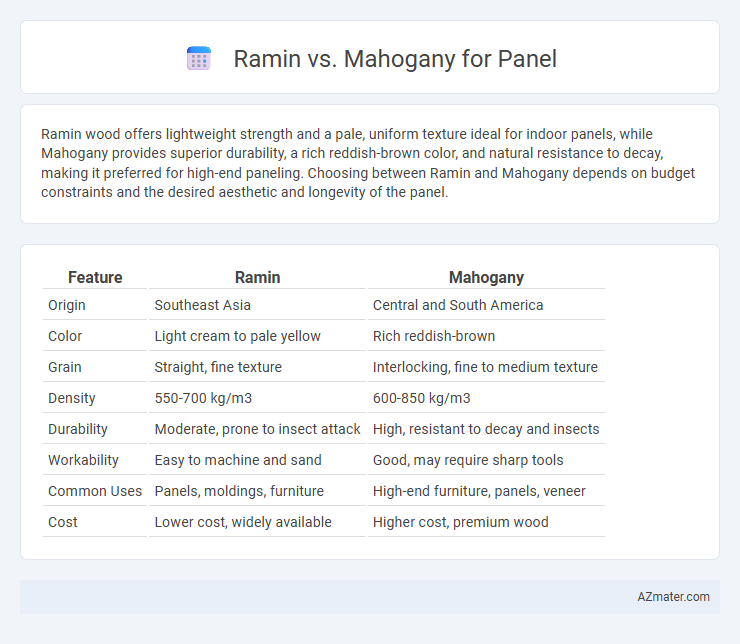Ramin wood offers lightweight strength and a pale, uniform texture ideal for indoor panels, while Mahogany provides superior durability, a rich reddish-brown color, and natural resistance to decay, making it preferred for high-end paneling. Choosing between Ramin and Mahogany depends on budget constraints and the desired aesthetic and longevity of the panel.
Table of Comparison
| Feature | Ramin | Mahogany |
|---|---|---|
| Origin | Southeast Asia | Central and South America |
| Color | Light cream to pale yellow | Rich reddish-brown |
| Grain | Straight, fine texture | Interlocking, fine to medium texture |
| Density | 550-700 kg/m3 | 600-850 kg/m3 |
| Durability | Moderate, prone to insect attack | High, resistant to decay and insects |
| Workability | Easy to machine and sand | Good, may require sharp tools |
| Common Uses | Panels, moldings, furniture | High-end furniture, panels, veneer |
| Cost | Lower cost, widely available | Higher cost, premium wood |
Introduction to Ramin and Mahogany for Paneling
Ramin and Mahogany are popular hardwoods used for paneling, each valued for distinctive qualities. Ramin, sourced from Southeast Asia, offers a pale, uniform texture ideal for smooth finishes and intricate carvings. Mahogany, renowned for its rich, reddish-brown hue and durability, provides a luxurious appearance and excellent resistance to warping, making it a premium choice for decorative panels.
Botanical Origins: Ramin vs Mahogany
Ramin (Gonystylus spp.) originates from Southeast Asian rainforests, primarily Indonesia and Malaysia, known for its pale yellow to light brown wood with a fine texture. Mahogany, typically from the Swietenia genus, is native to tropical Americas, especially regions like Central America and the Caribbean, prized for its reddish-brown color and rich grain patterns. Both woods belong to different botanical families--Ramin to the Thymelaeaceae family and Mahogany to the Meliaceae family--resulting in distinct physical and aesthetic properties ideal for panel applications.
Appearance: Grain Patterns and Colors
Ramin wood features a fine, straight grain with a pale yellow to light brown color, offering a uniform and smooth appearance ideal for sleek paneling. Mahogany exhibits a rich, reddish-brown hue with a more pronounced, interlocking grain pattern that provides a warm and elegant aesthetic. The distinct color depth and varied grain of mahogany create a luxurious finish, while ramin's subtle tones lend a more contemporary and clean look to panels.
Durability and Hardness Comparison
Ramin wood offers moderate durability with a Janka hardness rating of around 720, making it suitable for interior paneling but less resistant to heavy wear. Mahogany, known for its superior hardness averaging 900 to 1,070 Janka rating depending on the species, provides enhanced durability and resistance to dents and impacts in panel applications. For long-lasting, robust panels, mahogany outperforms ramin in hardness and overall durability, making it a preferred choice in high-traffic or demanding environments.
Workability: Cutting, Shaping, and Finishing
Ramin wood offers excellent workability, with smooth cutting, easy shaping, and a fine finish suitable for detailed panel work. Mahogany is also highly prized for its workability, providing clean cuts, effortless shaping, and a rich, smooth finish that enhances panel aesthetics. Both woods respond well to hand and power tools, but Ramin tends to be more affordable while maintaining comparable ease of finishing.
Cost Differences: Ramin vs Mahogany
Ramin wood generally costs less than mahogany due to its faster growth rate and wider availability in Southeast Asia, making it a more budget-friendly option for paneling. Mahogany, prized for its rich color and durability, commands a higher price because of slower growth and limited sustainable sources, leading to increased import and supply costs. Choosing between ramin and mahogany panels depends largely on budget constraints and desired aesthetic, with ramin offering affordability and mahogany delivering premium quality.
Sustainability and Environmental Impact
Ramin wood, sourced primarily from Southeast Asia, faces significant sustainability challenges due to overharvesting and habitat loss, leading to strict regulations and limited availability. Mahogany, often harvested from managed plantations, offers a more sustainable option when certified by organizations like FSC, as responsible forestry practices reduce deforestation and promote ecosystem balance. Both woods require careful consideration of sourcing and certification to minimize environmental impact and support sustainable panel production.
Common Applications in Paneling
Ramin wood is frequently used for interior paneling due to its smooth texture, light color, and ease of finishing, making it ideal for decorative walls and furniture surfaces. Mahogany, known for its rich reddish-brown color and durability, is favored in luxury paneling applications, including high-end cabinetry and architectural millwork. Both woods are valued for their dimensional stability and resistance to warping, but Ramin is typically preferred in cost-sensitive projects while Mahogany suits premium designs.
Maintenance and Long-Term Performance
Ramin panels require less frequent maintenance due to their resistance to warping and insect damage, making them suitable for environments with moderate humidity. Mahogany panels offer superior durability and a rich finish that ages well over time but may need periodic oiling and sealing to maintain their natural luster and prevent drying or cracking. Both woods provide solid long-term performance, but Ramin's low maintenance makes it ideal for cost-effective, long-lasting paneling in residential or commercial applications.
Conclusion: Choosing the Right Wood for Panels
Ramin and Mahogany offer distinct advantages for paneling; Ramin is lightweight, cost-effective, and features a smooth, pale texture ideal for painted finishes. Mahogany provides exceptional durability, rich reddish hues, and a luxurious grain, making it suitable for high-end, visually striking panels. Selecting the right wood depends on budget constraints, aesthetic preferences, and application requirements, with Ramin favored for economical projects and Mahogany preferred for premium, long-lasting panels.

Infographic: Ramin vs Mahogany for Panel
 azmater.com
azmater.com